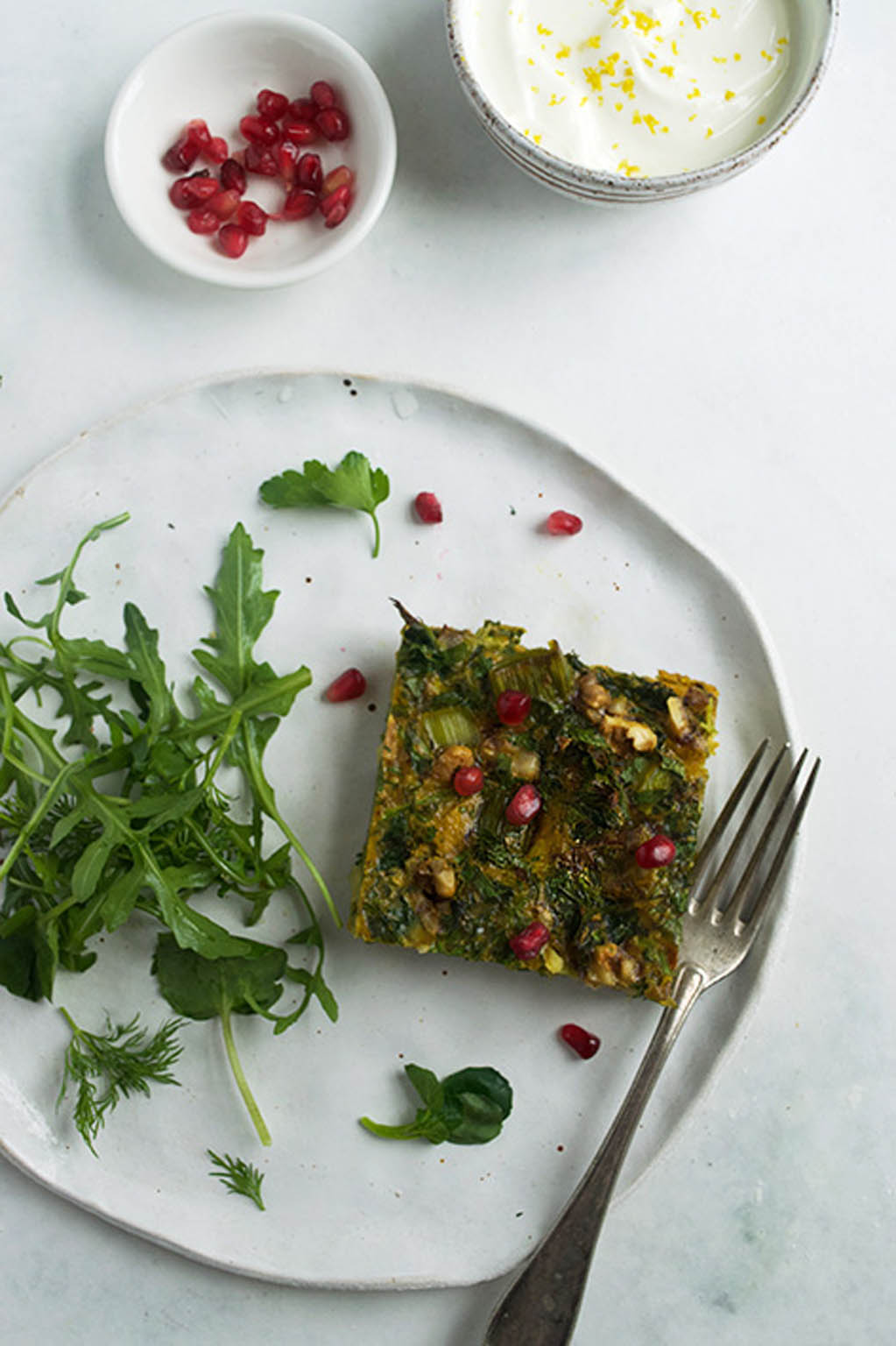If you’ve not heard of a kuku sabzi before, then simply it’s Persia’s take on a frittata, only much more flavourful and interesting. And green! Yes, it’s incredibly green. The interest lies in the combination of spices, nuts and dried fruit that are used in the filling. Not your average frittata then. If you’re bored of eating the same style frittata, then this Persian recipe will hopefully inspire a change to your repertoire.
The main difference between a kuku and frittata is that the egg is the supporting role to the filling, rather than the other way round. In the traditional version you barely know the egg is there. I’ve opted for a little more balance between the eggs and filling, but it’s still chock full of lovely soft herbs, leeks and spinach. It’s a fantastic example of how using an abundance of herbs really lifts a dish.
The recipe offers flexibility to add different vegetables such as pre-cooked courgette, green beans, broccoli, kale, cabbage or potato all work wonderfully. I’ve swapped the traditional walnuts for pine nuts but why not opt for pistachios instead; running with the extreme green theme! The original recipe uses dried barberries, a very tart tasting and ruby coloured berry used predominantly in Iranian cuisine. Seek them out online or in Middle Eastern stores, otherwise substitute with cranberries. There a nice-to-have store cupboard ingredient though and you can add them to Persian rice pilafs, stuffing mixes, salads or in a tagine.
The only thing to mention about cooking the kuku, is that it’s best to cook it low and slow. A golden bottom is what we’re seeking but overcooking the egg will make it a bit rubbery in texture. So check on it while finishing off in the oven. Using butter or ghee gives a wonderful flavour but feel free to use olive or coconut oil if you need. Similarly to a frittata, it’s always best to remove from the pan and leave until it’s just warm before tucking in. Serve with a dollop of Greek yogurt, olives, salad and flatbread. Enjoy!
Ingredients
½ tsp saffron
75g baby spinach (or 150g kale)
Knob of butter or 2 tbsp olive oil
2 medium size leeks, well cleaned and cut into 1cm slices
6 large eggs (might need 8)
15g dill, leaves picked and roughly chopped
25g parsley leaves, roughly chopped
25g coriander, roughly chopped
1½ tsp baking powder
¾ tsp fine sea salt
Good grind of black pepper
40g lightly toasted pine nuts, chopped
1 tsp garlic powder
½ tsp turmeric
½ tsp ground cumin
½ tsp cinnamon
¼ ground fenugreek
50g dried barberries or unsweetened cranberries
200ml Greek yogurt
½ lemon, juice and zest
Instructions
- Preheat your oven to 180°C, gas 4.
- Boil your kettle and put the saffron in a small cup. Add 2 tbsp of boiling water and leave to steep. Put the spinach in a colander over the sink and pour over enough boiling water to wilt. Once cool enough to handle, squeeze out the excess moisture and chop, fairly small.
- Heat the butter or olive oil in a 22cm frying pan. Once hot, gently sweat the leeks with a pinch of salt for about 8 minutes, stirring now an then, until soft. Leeks have a tendency to catch and burn easily, so having a lid on the pan keeps the condensation inside and gently cooks them releasing their natural sweetness.
- While the leeks are softening, make up your egg mixture. In a large jug, whisk your eggs well until light and airy, then stir in the saffron and its liquid, herbs, barberries, seasoning, walnuts and spinach until combined. Add in the spinach once egg mix in pan?
- Once the leeks are soft, add the spices. Make sure there’s enough butter or oil in the pan. Add a touch more if needed so that spices cook properly and removing the kuku from the pan is easier. Cook the spices for 1-2 minutes stirring now and again to stop them catching. Add in the egg mixture.
- Reduce the heat to medium low and cook gently for 20 minutes. Transfer to the oven for approx. 5 minutes to finish the cooking.
- While the kuku is in the oven, mix the yogurt with the zest and juice of ½ lemon and a touch of salt and pepper.
- Once the kuku is looking puffed up and golden. Remove the kuku and let it cool for 10 mins, then run a spatula around the edge and transfer onto a plate or board. Allow to cool until just warm. Scatter the kuku with the barberries, cut into segments and serve with the yogurt, green salad and warm flatbreads if you like.
Notes:
- You’ll need roughly a 22cm diameter non-stick pan, preferably one with a lid.
- A good tip for cleaning leeks is to put the prepared leek in a large bowl. Cover with water and swish around vigorously to remove the dirt, then strain.









